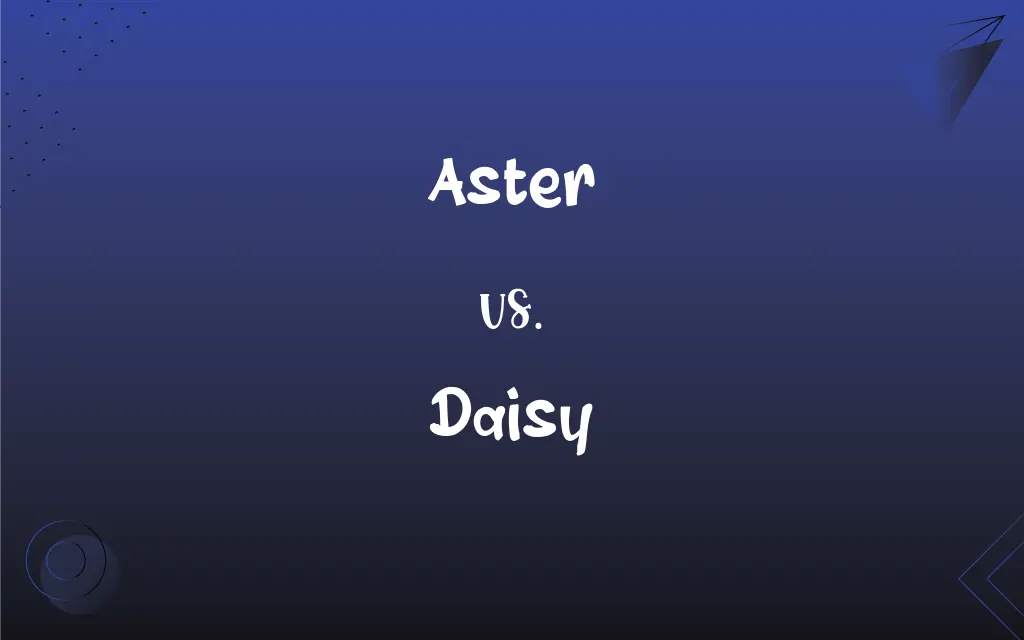Aster vs. Daisy: What's the Difference?
By Janet White || Updated on May 22, 2024
Aster and daisy are both flowering plants, with asters typically blooming in late summer to fall and having star-shaped flowers, while daisies often bloom in spring to early summer with a distinct central disc and surrounding petals.

Key Differences
Aster refers to a genus of flowering plants characterized by star-shaped blooms that come in various colors such as purple, pink, and white. These plants usually flower in late summer to fall, adding vibrant color to gardens as other flowers fade. Daisy, on the other hand, typically refers to plants in the genus Bellis, with the common daisy (Bellis perennis) being well-known. Daisies are recognizable by their simple, charming appearance featuring a yellow central disc and white or sometimes pink ray petals.
While asters are known for their star-shaped, dense clusters of small flowers, daisies have a more open and distinct petal arrangement. Asters thrive in various climates but prefer cooler temperatures for blooming, whereas daisies are hardy and adaptable, often found in lawns, gardens, and wildflower fields.
Asters offer a range of colors and bloom later in the year, extending the flowering season in gardens, whereas daisies bring early-season cheer with their bright and simple blooms. Both plants attract pollinators, contributing to garden biodiversity.
Comparison Chart
Botanical Family
Asteraceae
Asteraceae
Blooming Season
Late summer to fall
Spring to early summer
ADVERTISEMENT
Flower Shape
Star-shaped, dense clusters
Distinct central disc with ray petals
Common Colors
Purple, pink, white
White, yellow, sometimes pink
Preferred Climate
Cooler temperatures
Hardy and adaptable
Attractiveness to Pollinators
Yes
Yes
Symbolism
Patience, love, elegance
Innocence, simplicity
ADVERTISEMENT
Aster and Daisy Definitions
Aster
Plants in the genus Aster, known for their fall blooming.
Asters added color to the garden as autumn approached.
Daisy
A hardy plant often found in meadows and gardens.
Daisies are popular in wildflower mixes.
Aster
A perennial plant often used in borders and wildflower gardens.
She planted asters along the walkway for a burst of color.
Daisy
A common flowering plant with a yellow central disc and white petals.
The field was dotted with cheerful daisies.
Aster
A late-blooming flower that attracts butterflies.
The asters in her garden attracted many butterflies.
Daisy
A flower symbolizing innocence and purity.
She made a daisy chain to wear as a crown.
Aster
A flowering plant with star-shaped blooms.
The garden was filled with vibrant asters in late summer.
Daisy
A member of the Asteraceae family, known for its simple beauty.
The daisy is a symbol of simplicity and charm.
Aster
A member of the Asteraceae family.
Asters and daisies both belong to the Asteraceae family.
Daisy
A widely naturalized Eurasian plant (Leucanthemum vulgare syn. Chrysanthemum leucanthemum) having flower heads with a yellow center and white rays. Also called oxeye daisy, white daisy.
Aster
Any of various plants of the genus Aster or closely related genera in the composite family, having radiate flower heads with white, pink, or violet rays and usually a yellow disk.
Daisy
A low-growing plant (Bellis perennis) native to Europe and widely naturalized, having flower heads with white or pinkish rays. Also called English daisy.
Aster
The China aster.
Daisy
The flower head of any of these plants.
Aster
(Biology) A star-shaped structure formed in the cytoplasm of an animal cell during mitosis, having raylike microtubules that surround the centrosome.
Daisy
(Slang) One that is deemed excellent or notable.
Aster
Any of several plants of the genus Aster; one of its flowers.
Daisy
A wild flowering plant Bellis perennis of the Asteraceae family, with a yellow head and white petals
Aster
(biology) A star-shaped structure formed during the mitosis of a cell.
Daisy
Many other flowering plants of various species, mostly among the asterids.
Aster
(obsolete) A star.
Daisy
(Cockney rhyming slang) A boot or other footwear.
Aster
A genus of herbs with compound white or bluish flowers; starwort; Michaelmas daisy.
Daisy
A genus of low herbs (Bellis), belonging to the family Compositæ. The common English and classical daisy is Bellis perennis, which has a yellow disk and white or pinkish rays.
Aster
A plant of the genus Callistephus. Many varieties (called China asters, German asters, etc.) are cultivated for their handsome compound flowers.
Daisy
Any of numerous composite plants having flower heads with well-developed ray flowers usually arranged in a single whorl
Aster
A star-shaped figure of achromatic substance found chiefly in cells dividing by mitosis.
Daisy
Plants in the genus Bellis, especially Bellis perennis.
The lawn was covered in small daisies after the rain.
Aster
Any of various chiefly fall-blooming herbs of the genus Aster with showy daisylike flowers
Aster
Star-shaped structure formed in the cytoplasm of a cell having fibers like rays that surround the centrosome during mitosis
FAQs
What colors do asters come in?
Asters come in various colors, including purple, pink, and white.
What is an aster?
An aster is a flowering plant with star-shaped blooms, typically blooming in late summer to fall.
Do asters attract pollinators?
Yes, asters attract pollinators like bees and butterflies.
Do daisies attract pollinators?
Yes, daisies also attract pollinators.
Are daisies hardy plants?
Yes, daisies are hardy and adaptable, often thriving in various conditions.
Can asters thrive in cooler temperatures?
Yes, asters prefer cooler temperatures for blooming.
When do daisies typically bloom?
Daisies often bloom in spring to early summer.
What colors do daisies come in?
Daisies are usually white with a yellow center but can sometimes be pink.
What is a daisy?
A daisy is a flowering plant with a yellow central disc and white or sometimes pink petals, often blooming in spring to early summer.
When do asters typically bloom?
Asters typically bloom in late summer to fall.
Are daisies perennials?
Common daisies (Bellis perennis) are perennials, but there are also annual daisy varieties.
What is the symbolism of asters?
Asters symbolize patience, love, and elegance.
Do daisies require special care?
Daisies are hardy and easy to care for, needing regular sunlight and watering.
Are asters and daisies in the same botanical family?
Yes, both asters and daisies belong to the Asteraceae family.
Are asters perennials?
Yes, most asters are perennials, meaning they return year after year.
What is the symbolism of daisies?
Daisies symbolize innocence and simplicity.
Can daisies be used in floral arrangements?
Yes, daisies are also popular in floral arrangements for their cheerful appearance.
Do asters require special care?
Asters are relatively low-maintenance but thrive with regular watering and well-drained soil.
Can asters be used in floral arrangements?
Yes, asters are popular in floral arrangements for their vibrant colors.
Are both asters and daisies beneficial for garden biodiversity?
Yes, both asters and daisies attract pollinators, contributing to garden biodiversity.
About Author
Written by
Janet WhiteJanet White has been an esteemed writer and blogger for Difference Wiki. Holding a Master's degree in Science and Medical Journalism from the prestigious Boston University, she has consistently demonstrated her expertise and passion for her field. When she's not immersed in her work, Janet relishes her time exercising, delving into a good book, and cherishing moments with friends and family.































































